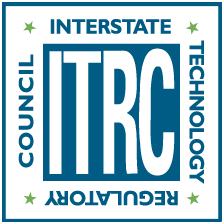Acknowledgments
The members of the ITRC LNAPL Update Team wish to acknowledge the individuals, organizations, and agencies that contributed to this Technical and Regulatory Web-based Guidance Document.
The team also wishes to recognize the efforts of the following individuals as authors and contributors to the text and organization of the guidance:
The Team recognizes the efforts and important contributions of the following state environmental personnel:
Team Leaders
- Randy Chapman, Virginia Department of Environmental Quality
- Erik Gessert, Colorado Department of Labor and Employment–Division of Oil and Public Safety
Members
- Tom Fox, Colorado Department of Labor and Employment–Division of Oil and Public Safety
- Ahad Chowdhury, Kentucky Division of Waste Management
- West Johnson, Kentucky Division of Waste Management
- Laura Luther, Missouri Department of Natural Resources
- David Harn, Michigan Department of Environmental Quality
- Nick Swiger, Michigan Department of Environmental Quality
- Justin Meredith, Tennessee Department of Environment and Conservation
- Geina Skinner, Tennessee Department of Environment and Conservation
- David Lerner, Delaware Department of Natural Resources and Environmental Control
- Brett Tavener, Kansas Department of Health and Environment
- Tim Post, California, Regional Water Quality Control Board
- Ken Marra, Massachusetts Department of Environmental Protection
- Ricardo Jaimes, Washington DC Department of Energy and Environment
- Brian Barone, Washington DC Department of Energy and Environment
- David Swimm, Wisconsin Department of Natural Resources
The Team recognizes the efforts and valuable contributions of the following academic and stakeholder representatives:
- J.R. Capasso, Public Stakeholder
- Iona Black, Yale University, Public Stakeholder
- Laura Gelles, Utah State University
The Team recognizes the efforts and valuable contributions of the following consultants and industry representatives:
- Larry Acomb, Geosphere, Inc.
- Rick Ahlers, Arcadis
- Sam Baushke, Barr Engineering Company
- Dave Bennett, Groundwater and Environmental Services, Inc.
- Melissa Boysun, Environmental Resource Management
- Daniel Canavan, Kleinfelder
- Ramona Darlington, Battelle
- David de Courcy-Bower, Environmental Resources Management
- Lloyd Dunlap, Trihydro
- Joann Dyson, West Central Environmental Consultants, Inc.
- Kate Fogarty, TRC
- Steve Gaito, AECOM
- Sanjay Garg, Shell
- Jeffrey Hale, Kleinfelder
- Mike Hawthorne, GEI Consultants, Inc.
- Ian Hers, Golder Associates, Ltd.
- Harley Hopkins, ExxonMobil
- Trevor King, AECOM
- Andrew Kirkman, BP
- Brad Koons, AECOM
- Poonam Kulkarni, GSI Environmental, Inc.
- Mark Lyverse, Chevron
- Mark Malander, ExxonMobil
- Rob McGrath, Woodard and Curran
- Christopher Mulry, Groundwater and Environmental Services, Inc.
- Ranga Muthu, Parsons Corporation
- Nadira Najib, Langan Engineering and Environmental Services
- Eric Nichols, Substrata LLC.
- Tom Palaia, CH2M Hill
- Andy Pennington, Arcadis
- Keith Piontek, TRC
- Lisa Reyenga, GEI Consultants, Inc.
- Matthew Rousseau, GHD
- Mir SeyedAbbasi, BP
- Natasha Sihota, Chevron
- Jon Smith, AECOM
- Douglas Sours, GHD
- Sarah Stoneking, Ramboll Environmental
- Malcolm Thomas, Langan Engineering and Environmental Services
- Derek Tomlinson, GEI Consultants, Inc.
- Donald Weir, True Blue Technology, Inc.
- Yaning Yang, GHD
- Christine York, Wood PLC
- Matthew Zenker, AECOM
- Julio Zimbron, E-Flux
The Team recognizes the efforts and valuable contributions of the following federal personnel:
- Andrea Barbery, USEPA Office of Intergovernmental Relations
- Paul Beam, DOE HQ EM-12, Groundwater and Soil Remediation
- Travis Borrillo, NAVFAC Engineering and Expeditionary Warfare Center (EXWC)
- Terrence Johnson, USEPA Office of Superfund Remediation and Technology Innovation (OSRTI)
- Ray Ledbetter, USEPA Office of Superfund Remediation and Technology Innovation (OSRTI)
- Mark Rothas, United States Army Corps of Engineers (USACE)
- Alex Teimouri, DOE HQ EM-12, Groundwater and Soil Remediation
- Tom Walker, USEPA Office of Underground Storage Tanks (OUST)
Many others offered advice, suggestions, reviews and edits.
As part of the broader ITRC effort, the LNAPL Update Team effort is funded by the U.S. Department of Energy, the U.S. Department of Defense, the U.S. Environmental Protection Agency, and the ITRC Industry Affiliates Program.


